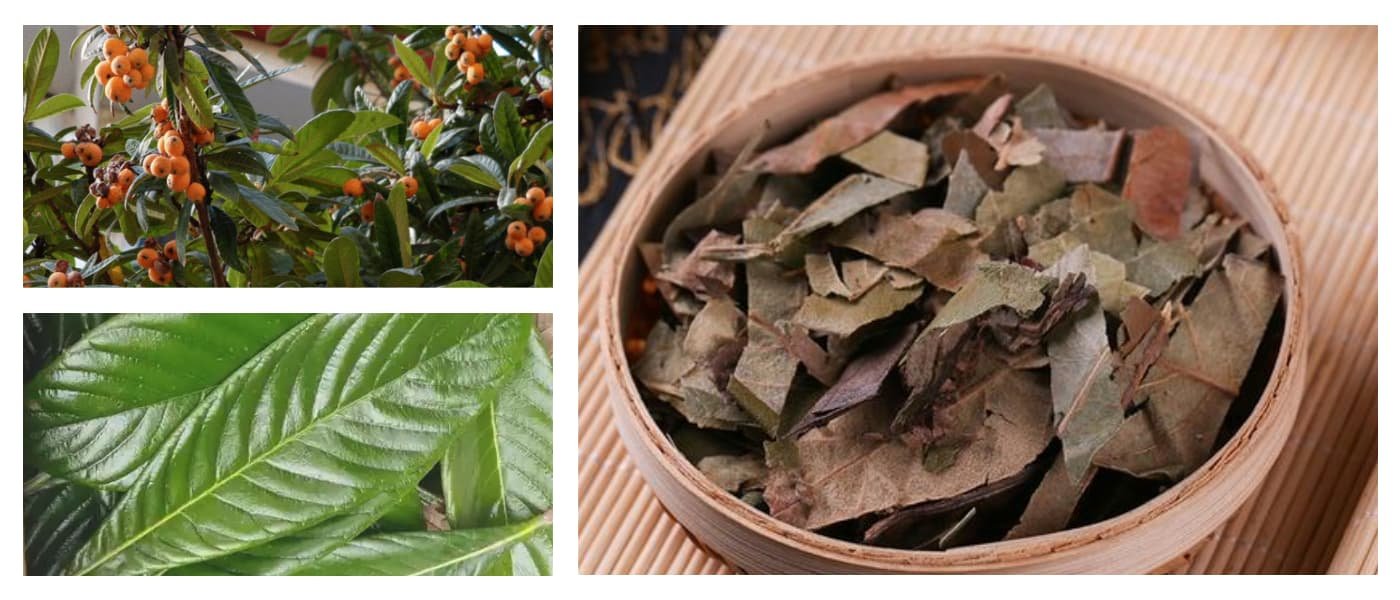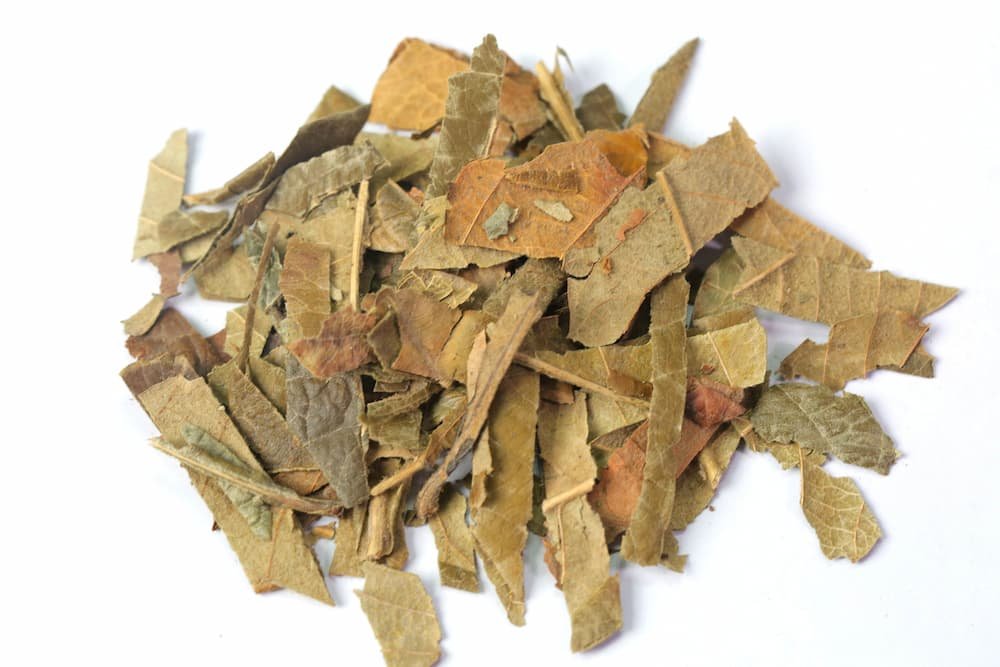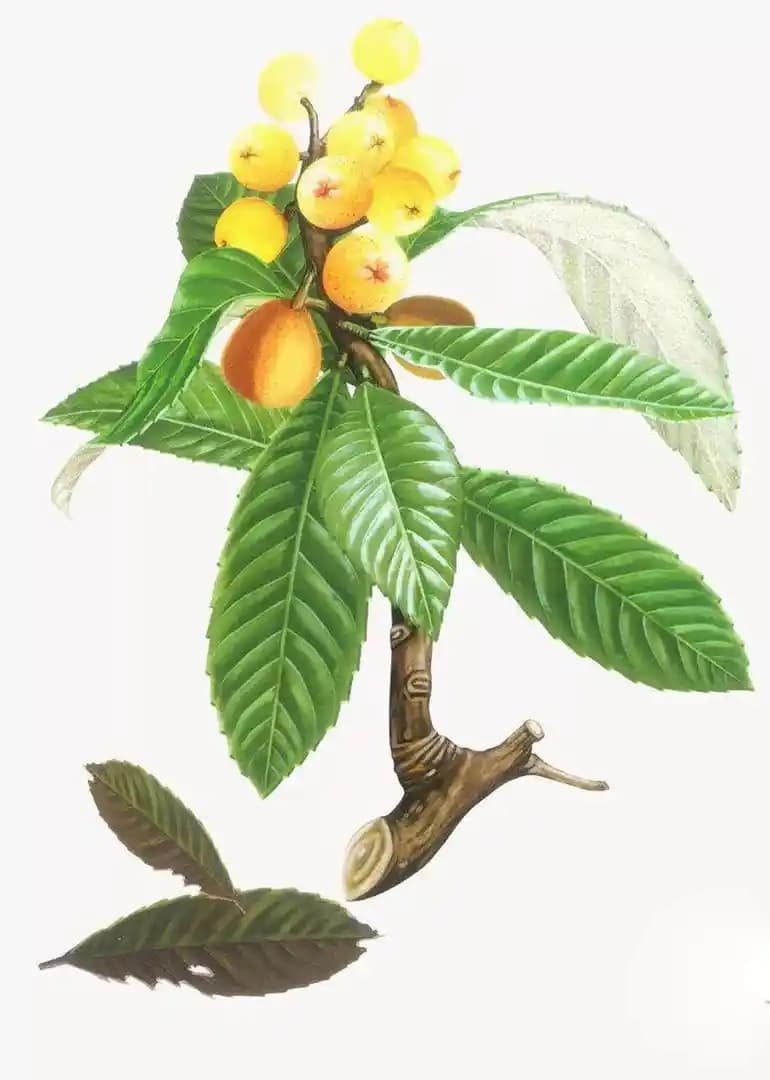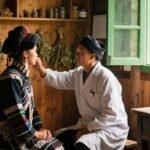Loquat Leaf (Pi Pa Ye,Loquat Leaves,Folium Eriobotryae)

What Is Loquat Leaf (Pi Pa Ye)?
Loquat Leaf (Pi Pa Ye) refers to the dried leaves of Eriobotrya japonica (Thunb.) Lindl., a member of the Rosaceae family. After sun-drying, the leaves are used in Traditional Chinese Medicine (TCM).
Nature and Flavor: Bitter in taste, slightly cold in nature
Meridian Affiliation: Lung and Stomach
Functions: Clears the lungs and stops coughing; descends rebellious Qi and stops vomiting.
Indications:
1. Cough with Lung-Heat, shortness of breath due to Qi rebellion: This herb’s bitter flavor helps to descend Qi, and its cool nature clears heat. It is especially effective for dispersing Lung-Heat and calming wheezing.
2. Vomiting due to Stomach-Heat, hiccups: Loquat Leaf clears excess heat from the Stomach and descends Qi, alleviating nausea and hiccups.
What Are the Benefits of Loquat Leaf (Pi Pa Ye)?
Traditional Uses
- Clears Lung-Heat and stops cough
- Descends Stomach-Qi to stop nausea or hiccups
Modern Pharmacological Effects
- Antitussive and Anti-inflammatory: Contains pentacyclic triterpenic acids that inhibit human neutrophil elastase (HNE), aiding in (used in traditional contexts) of chronic bronchitis and persistent cough.
- Antibacterial and Antiviral: Extracts inhibit HIV protease and multiple foodborne bacteria. Efficacy increases with concentration.
- Antioxidant: Flavonoids and polyphenols in Loquat Leaf show strong free radical scavenging abilities, outperforming tea polyphenols and ascorbic acid.
- Blood Sugar Regulation: Polysaccharides and corosolic acid improve glucose metabolism and increase insulin secretion in diabetic mice.
- Liver Protection: Total triterpenes reduce liver fat accumulation and cholesterol, while total flavonoids protect against liver damage.
How to Use It
Internal Use: Decoction, 5–10 grams.
For cough: use charred Loquat Leaf.
For vomiting: use the raw form.
Medicinal Recipes & Dietary Applications
Mulberry & Loquat Leaf Tea
- Effects: Clears Liver, disperses Wind-Heat, transforms phlegm, relieves exterior syndromes. Effective for Liver-Fire symptoms and Wind-Heat colds.
- Ingredients: 10g each of Mulberry Leaf, Wild Chrysanthemum, and Loquat Leaf.
- Preparation: Coarsely grind all ingredients.
- Dosage: Drink frequently as tea.
Loquat Leaf and Honey Tea
Steep fresh Loquat Leaves and honey in hot water to moisten lungs and relieve cough.
Loquat Leaf, Ginger Juice, and Honey Tea
Mix Loquat Leaf with ginger juice and honey. This tea warms the body, transforms phlegm, and relieves cold-induced cough.

Precautions and Side Effects
- When used in decoctions, Loquat Leaf should be wrapped for boiling to avoid irritation.
- Not suitable for vomiting due to Cold in the Stomach or Wind-Cold coughs.
Wild vs. Organic Loquat Leaf
What Is Wild Loquat Leaf?
Wild Loquat Leaf grows naturally in mountains and forests without human intervention. These leaves are unexposed to fertilizers or pesticides. Though traditionally viewed as more potent, proper identification is crucial to avoid toxic contamination or misidentification.
What Is Organic Loquat Leaf?
Organic Loquat Leaf comes from trees cultivated under certified organic standards—no synthetic chemicals, GMOs, or artificial fertilizers. Environmental quality is strictly monitored. Active ingredients are more consistent, making it ideal for teas, formulas, and health supplements.
References on Eriobotrya japonica (Loquat Leaf)
Loquat Leaf Phytochemistry and Constituents
1. Tian Y, et al. Traditional uses, phytochemistry, pharmacology, and toxicity of Eriobotrya japonica leaves: A comprehensive review. Journal of Ethnopharmacology. 2022;295:115422.
View Article
2. Wang L, et al. Research Progress on Extraction and Separation of Active Components from Loquat Leaves. Separations. 2023;10(2):126.
View Article
3. Li Y, et al. Loquat and its phytochemical potential: A promising application in food technology. Food Frontiers. 2023;4(3):158.
View Article
4. Kumari DKS, Selvam SIK. Phytoconstituents screening of loquat leaf extract using different solvents and antioxidant potential assessment. Asian Journal of Biological and Life Sciences. 2023;12(2):378-385.
View Article
5. Chen H, et al. Characterization of phenolic compounds from Loquat leaves and their antioxidant activities. Food Chemistry. 2019;277:554-561.
View Article
6. Liu Y, et al. Chemical constituents and pharmacological activities of Eriobotrya japonica. Phytochemistry Reviews. 2020;19(6):1387-1410.
View Article
7. Zhang Y, et al. Qualitative and quantitative analysis of flavonoids in loquat leaves by HPLC-MS/MS and HPLC. Molecules. 2018;23(3):572.
View Article
8. Sun X, et al. Metabolite profiling of loquat leaves: A comprehensive study. Journal of Agricultural and Food Chemistry. 2021;69(10):3113-3125.
View Article
9. Deng G, et al. Extraction optimization and antioxidant activity of polyphenols from Eriobotrya japonica leaves. Food Science and Biotechnology. 2020;29(7):885-892.
View Article
10. Wang Y, et al. Comparative study on the chemical constituents in different parts of loquat. Natural Product Research. 2017;31(12):1414-1417.
View Article
Loquat Leaf Pharmacology and Bioactivities
11. Zheng Y, et al. Anti-inflammatory effects of triterpene acids from Eriobotrya japonica leaves. Journal of Ethnopharmacology. 2021;270:113847.
View Article
12. Han Y, et al. The antitumor activities of Eriobotrya japonica leaf extracts in human cancer cells. Phytomedicine. 2020;76:153234.
View Article
13. Wu X, et al. Protective effects of loquat leaf extract against acute liver injury in mice. Pharmaceutical Biology. 2019;57(1):118-124.
View Article
14. Liu S, et al. Antidiabetic effects of polysaccharides extracted from loquat leaves. International Journal of Biological Macromolecules. 2020;162:1498-1507.
View Article
15. Kim YJ, et al. Anti-obesity effects of Eriobotrya japonica leaf extract in high-fat diet-induced obese rats. Nutrition Research and Practice. 2021;15(2):132-140.
View Article
16. Park SJ, et al. Antioxidant and anti-aging activities of loquat leaves. Oxidative Medicine and Cellular Longevity. 2020;2020:3216792.
View Article
17. Dai Y, et al. Neuroprotective effects of Eriobotrya japonica leaf extract in a Parkinson’s disease model. Frontiers in Pharmacology. 2021;12:684129.
View Article
18. Zeng Y, et al. Anti-arthritic effects of loquat leaves: Modulation of inflammatory cytokines. International Immunopharmacology. 2020;86:106731.
View Article
19. Wang T, et al. Effects of Eriobotrya japonica leaves on cardiovascular health. Phytotherapy Research. 2022;36(4):1570-1582.
View Article
20. Xu W, et al. Immunomodulatory activities of loquat leaf polysaccharides. Carbohydrate Polymers. 2019;223:115055.
View Article
Loquat Leaf Clinical and Applied Studies
21. Kim J, et al. Clinical evaluation of loquat leaf syrup for chronic cough in adults: A randomized controlled trial. Complementary Therapies in Medicine. 2021;58:102706.
View Article
22. Li X, et al. Clinical study on the efficacy of loquat leaf decoction in patients with mild COVID-19 symptoms. Phytomedicine. 2022;100:154042.
View Article
23. Zhang J, et al. Eriobotrya japonica leaf-based therapy for gastric ulcer patients: A clinical pilot study. Clinical Nutrition ESPEN. 2021;44:224-229.
View Article
24. Liu Q, et al. Application of loquat leaf extract in oral health management: A randomized trial. Evidence-Based Complementary and Alternative Medicine. 2020;2020:9463257.
View Article
25. Park SY, et al. Clinical potential of loquat leaf tea on glucose metabolism: A double-blind placebo-controlled trial. Diabetes Research and Clinical Practice. 2019;151:225-232.
View Article
26. Seo S, et al. Clinical evidence of loquat leaf extract for skin aging in humans. Journal of Cosmetic Dermatology. 2020;19(11):2814-2821.
View Article
27. Huang T, et al. Clinical effects of Eriobotrya japonica syrup on pediatric asthma: A randomized controlled study. Journal of Pediatric Nursing. 2021;58:e38-e45.
View Article
28. Li Z, et al. Randomized controlled trial of loquat leaf extract in patients with hyperlipidemia. Phytotherapy Research. 2022;36(3):1325-1332.
View Article
29. Zhao J, et al. Effectiveness of loquat leaf-based therapy on allergic rhinitis: A clinical study. International Archives of Allergy and Immunology. 2020;182(5):456-462.
View Article
30. Chen L, et al. Loquat leaf extract reduces oxidative stress in patients with chronic fatigue syndrome: A clinical trial. Journal of Alternative and Complementary Medicine. 2021;27(7):569-577.
View Article
Chinese Materia Medica (Zhong Hua Ben Cao):Loquat Leaf (Pi Pa Ye)

Other Names
Ba Ye, Pi Pa, Honey Loquat Leaf, Roasted Loquat Leaf, Lu Ju Leaf
Source
Originally recorded in Famous Physicians’ Extra Records (Ming Yi Bie Lu).
1. Treatise on Herbal Processing by Lei Gong (Lei Gong Pao Zhi Lun): When using Loquat Leaf (Pi Pa Ye), it is ideal to collect fresh leaves that weigh about 1 liang each. Dried ones should weigh about 1 liang for every three leaves. If they meet this standard, the Qi is sufficient and the leaves are usable.
2. Tao Hongjing stated: Loquat Leaf does not require boiling. Simply chewing it brings relief to illnesses. When used as a drink, it is slightly cooling.
Botanical Origin
The medicinal material comes from the leaves of Eriobotrya japonica (Thunb.) Lindl. [Mespilus japonica Thunb.], a plant in the Rosaceae family.
Collection and Storage
Can be harvested year-round.
Habitat and Distribution
Ecological Environment: Commonly cultivated at village edges, plains, or hillsides.
Geographic Distribution: Found in southern and central China, including provinces such as Shaanxi, Gansu, Jiangsu, Anhui, Zhejiang, Jiangxi, Fujian, Taiwan, Sichuan, Guizhou, and Yunnan.
Botanical Description
Loquat (Pi Pa) is a small evergreen tree reaching about 10 meters in height. Young branches are thick, yellowish-brown, and covered with rusty or grayish-brown felt-like hairs. Leaves are leathery, short-petioled or nearly sessile, 6–10 mm long with grayish-brown hair. The stipules are awl-shaped and hairy. Leaf blades are lanceolate, oblanceolate, obovate, or long-elliptical, 12–30 cm long, 3–9 cm wide, with sharply pointed or gradually tapering tips and wedge-shaped bases. The upper edges are sparsely serrated, and the surface is glossy and wrinkled. The undersides and veins are densely covered with grayish-brown hair. Lateral veins are arranged in 11–21 pairs. The inflorescence is a terminal panicle, with peduncles and pedicels densely covered in rusty hairs. Flowers are 1.2–2 cm in diameter. The calyx is shallowly cup-shaped with triangular-ovate sepals and rusty hair. Petals are white, oblong to ovate, 5–9 mm long, 4–6 mm wide, clawed at the base, and hairy. There are 20 stamens and 5 free styles with capitate stigmas, glabrous. The fruit is spherical to oblong, 3–5 cm in diameter, yellow to orange-yellow. Seeds number 1–5, round or flattened-round, 1–1.5 cm in diameter, brown, shiny, with papery seed coats.
Flowering period: October–December
Fruiting period: May–June the following year
Cultivation
Biological Characteristics: Prefers warm, humid climates with average annual temperatures above 12–15°C and over 1000 mm of rainfall. Loquat can grow in various soils but thrives best in deep, well-drained, humus-rich sandy soil.
Propagation Techniques: Propagation is by seed or grafting.
Seed Propagation: Seeds mature in May–June and should be sown immediately. Use strip or point sowing, cover with soil and straw, water to maintain moisture, and germination occurs within a month. After one year, transplant in the following spring.
Grafting: Common rootstocks include Taiwanese Loquat and Photinia. Grafting is done via scion methods like wedge grafting or bark grafting depending on stock size, usually between March and June. Seedlings are ready for field planting after 1–2 years of cultivation.
Field Management
Apply fertilizer four times a year:
1. Before spring shoot emergence (Feb–Mar)
2. During fruit expansion (late March–early April)
3. After harvesting and before summer shoots (June)
4. Before flowering (October)
Fertilizer ratio (N:P:K) = 4:2.5:3. Pruning is required in spring and summer.
Pest and Disease Control
Leaf and Fruit Blight: Caused by gray spot disease; remove and burn infected parts to improve ventilation.
Loquat Hairy Caterpillar: Larvae damage young shoots and leaves; spray with 1000x dilution of 90% dichlorvos during outbreak.
Properties
Macroscopic Identification:
Leaves are long-elliptical or obovate, 12–30 cm long, 3–9 cm wide. Tips are pointed; bases are wedge-shaped. The upper edge has sparse serrations while the base is entire. The upper surface is gray-green, yellowish-brown, or reddish-brown and glossy; the underside is light gray or brownish-green with dense yellow fuzz. The main vein is prominently raised on the underside; lateral veins are feather-like. Petiole is extremely short with brownish-yellow fuzz. Leaves are leathery, brittle, and easily broken.
Slight odor; slightly bitter taste.
High-quality leaves are complete and gray-green.
Microscopic Identification
Cross-section shows flattened upper epidermal cells with a thick cuticle; lower epidermis contains numerous single-celled non-glandular hairs, often curved near main veins and sometimes folded like a zigzag. Stomata are of the anomocytic type. Palisade tissue has 3–4 layers of cells; spongy tissue is loose. Main vein contains a nearly ring-shaped collateral vascular bundle. The central vascular bundle sheath includes lignified fiber bundles, surrounded by parenchyma cells containing calcium oxalate crystals, forming crystal fibers. Mucilage cells and additional calcium oxalate crystals are found in the main vein and mesophyll.
Chemical Constituents
Fresh leaves contain 0.045%–0.108% volatile oil, mainly nerolidol and farnesol. Other compounds include:
– Amygdalin
– Tartaric acid
– Citric acid
– Malic acid
– Oleanolic acid
– Ursolic acid
– 2α-Hydroxyursolic acid
– 6α,19α-Dihydroxyursolic acid
– Maslinic acid
– Eriobofuran
– Loquatifolin A
– Hyperoside
– Four sesquiterpene glycosides:
1. Nerolidol-3-O-α-L-rhamnopyranosyl-(1→2)-β-D-glucopyranoside
2. Nerolidol-3-O-α-L-rhamnopyranosyl-(1→4)-α-L-rhamnopyranosyl-(1→2)-β-D-glucopyranoside
3. Nerolidol-3-O-α-L-rhamnopyranosyl-(1→4)-α-L-rhamnopyranosyl-(1→6)-β-D-glucopyranoside
4. Nerolidol-3-O-[α-L-rhamnopyranosyl-(1→4)-α-L-rhamnopyranosyl-(1→2)-{α-L-rhamnopyranosyl-(1→6)}-β-D-glucopyranoside
Pharmacological Effects
The amygdalin contained in the herb can be broken down by microbial enzymes in the lower digestive tract, releasing trace amounts of hydrocyanic acid, which has a sedative effect on the respiratory center. As a result, it helps relieve cough and asthma.
The ether cold extract of Loquat Leaf (Pi Pa Ye) has shown strong local anti-inflammatory activity against carrageenan-induced edema, with an inhibition rate of 52% two hours after carrageenan injection. The active components have been identified as ursolic acid and 2a-hydroxy-linoleic acid methyl ester, the latter being equivalent to the methylated derivative of maslinic acid. In addition, the methanol extract of the leaf contains sesquiterpene glycosides and polyhydroxy triterpenoid glycosides that significantly reduce urinary glucose levels in genetically diabetic mice. The latter compound also lowers blood glucose levels in normal mice.
Processing Methods
- Loquat Leaf (Pi Pa Ye): The fuzz is brushed off, the leaf is washed with water, slightly moistened, cut into shreds, and dried under the sun.
- Honey-prepared Loquat Leaf (Mi Zhi Pi Pa Ye): Shredded leaves are mixed with refined honey and an appropriate amount of boiling water, stirred evenly, allowed to sit briefly, then stir-fried over low heat until they no longer stick to the hands. Afterward, the product is cooled for storage. (For every 100 jin of leaf shreds, 25 jin of refined honey is used.)
Meridian Affiliation
Lung; Heart; Stomach
Nature and Flavor
Bitter, pungent; cold; non-toxic
Precautions
According to Annotations on Materia Medica (Ben Cao Jing Shu): This herb should be avoided in cases of vomiting due to cold in the stomach and coughs caused by wind-cold affecting the lungs.
Functions and Indications
Clears the lungs and relieves cough; harmonizes the stomach and redirects rebellious Qi; quenches thirst.
Indicated for: cough due to lung heat with phlegm; chronic cough from yin deficiency; hemoptysis; epistaxis; vomiting and hiccups due to stomach heat.
Dosage and Administration
Internal use: decoction, 9–15 grams; can be used in large doses up to 30 grams. For fresh leaves: 15–30 grams. It can also be used in syrup form or made into pills or powders.
Commentaries from Classical Texts
- Compendium of Materia Medica (Ben Cao Gang Mu):
Loquat Leaf treats disorders of the lungs and stomach mainly by promoting the downward flow of Qi. When Qi flows downward, internal fire is subdued and phlegm descends. Consequently, rebellious Qi is resolved, vomiting ceases, thirst is quenched, and coughing is stopped. - Annotations on Materia Medica (Ben Cao Jing Shu):
All conditions involving rebellious upward movement of Qi are associated with fire. When fire ascends, symptoms like constant retching (哕) occur. Withering of trees results in falling leaves, just as severe disease manifests in harsh sounds of retching. Loquat Leaf is cool in nature and excels at guiding Qi downward. When Qi descends, fire does not ascend, thus calming the stomach and stopping the retching. It is effective for persistent vomiting, dry mouth postpartum, excessive thirst, cough from lung heat, wheezing, upward-rising Qi in beriberi, and even for regulating menstruation and enhancing fertility when combined with yin-nourishing and heat-clearing herbs. - Collected Sayings on Materia Medica (Ben Cao Hui Yan):
Loquat Leaf calms the stomach Qi, moistens the heart and lungs, and nourishes the liver and kidneys. According to Shen Kongting: It stops incessant vomiting due to reversed stomach Qi; moistens the lungs in coughs caused by Qi rebellion and phlegm stagnation; nourishes kidney Qi when internal fire causes irritability and dryness; and cools the heart when thirst arises from epidemic heat or summer-heat conditions. - Random Notes from Chongqing Hall (Chong Qing Tang Sui Bi):
Loquat Leaf is applicable in cases of wind-warmth, heat-warmth, summer-heat, and dryness affecting the lungs, helping to protect Metal and regulate Qi. Its aromatic but non-drying nature makes it useful in epidemic, damp-warm, and foul-toxin conditions affecting the stomach. Although praised for its Qi-lowering and cough-relieving effects, its full potential deserves further emphasis. - Supplement to the Materia Medica by Famous Physicians (Ming Yi Bie Lu):
Primarily treats sudden, incessant retching and descends Qi. - Dietary Materia Medica (Shi Liao Ben Cao):
Boil the leaf and drink the juice to relieve thirst and treat coughing from lung heat and lung abscesses, as well as chest and facial ulcers. - Materia Medica of Southern Yunnan (Dian Nan Ben Cao):
Stops coughing, reduces phlegm, calms asthma; effective in resolving stringy phlegm, dissolving stubborn phlegm, alleviating hoarseness, and relieving breathlessness. - Compendium of Materia Medica (Ben Cao Gang Mu):
Harmonizes the stomach and descends Qi, clears heat, relieves summer-heat toxicity, and treats beriberi. - New Additions to the Materia Medica (Ben Cao Zai Xin):
Clears lung Qi, reduces lung fire, stops cough, dissolves phlegm, and treats vomiting and hemoptysis. Also effective against sores and heat-toxicity. - Medicinal Materials of Anhui (An Hui Yao Cai):
The decoction can be used as a wash for purulent sores, ulcers, and hemorrhoids.
The information provided on this page regarding traditional Chinese medicinal herbs is for educational and informational purposes only. It is not intended as medical advice, diagnosis, or (used in traditional contexts).



Leave a Reply